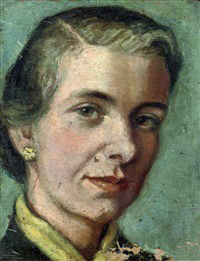Nadia Benois
Nadia Benois | |
|---|---|
| Надежда Бенуа | |
 Self-portrait | |
| Born | Nadezhda Leontievna Benois 17 May 1896[1] Saint Petersburg, Russian Empire |
| Died | 8 December 1975 (aged 79) Gloucestershire, England |
| Occupation(s) | Artist, painter |
| Spouse | Jona von Ustinov |
| Children | Peter Ustinov |
| Relatives | Tamara Ustinov (granddaughter) |
Nadezhda Leontievna Ustinova (
Personal life
Nadia Benois, born Nadezhda Leontievna Benois in Saint Petersburg, was the youngest daughter of Leon Benois, a Russian architect. Nadezhda studied to be an artist at
She died on 8 December 1975 in Gloucestershire.[5]
Artistic career
Painting work
In the course of her travels, Benois painted the impressionist landscapes of London, Wales, Ireland, and Scotland.
Design work
Benois was regarded as a figure of leadership in her design career.[9] She was the scenery and costume designer for The Descent of Hebe.[10] Antony Tudor has stated that Benois' work was the inspiration for the choreography of this work.[11][12] She also designed the stage for the ballet Cap over Mill, which was part of the Dark Elegies.[13] Benois' work in Cap over Mill has been positively regarded as "striking décor".[14] Her contributions to Dark Elegies have been credited as a key addition to the timelessness of the work.[15] Benois was also credited for her work adding to the qualities which made Dark Elegies stand as a unique experience.[16][17] In 1938, Benois designed the set and the costumes for La Péri. Despite the praise that was given to Benois' contributions, the performance was withdrawn due to criticism towards the choreographer.[18] Her work on The Sleeping Princess has been criticized, with this criticism stimming from the low budget she was given.[19] In 1948, Benois commented about her work on Lady into Fox, claiming it to be her "gem above all gems".[20] A performer for Lady into Fox has also praised Benois' design, claiming that the costume which she had designed for her to use was "perfect".[21]
Later, Benois created costumes and sets for the films Vice Versa (1948) and Private Angelo (1949), both written and directed by her son, Peter.[22][23]
Notable works
Paintings
- "Kensington Gardens" (Manchester City Art Gallery, 1937)
Group Exhibitions
"Three Women Painters" by Nadia Benois, Clare Crossley, Nancy Tennant (Michael Parkin Gallery, 1975)
Design Productions
- "The Descent of Hebe" (1935)
- "Dark Elegies"(1937)
- "La Péri" (1938)
- "The Sleeping Princess" (1939)
- "Lady into Fox" (1939)
- "Cap Over Mill" (1940)
References
- ^ Dolman, Bernard, ed. (1962). Who's who in Art (11 ed.).
- ISBN 978-0191024177.
- ISBN 1859284272.
- ISBN 978-1849549462.
- ISBN 978-1-907200-05-2.
- ^ "Искусство и архитектура русского зарубежья - БЕНУА (в замуж. Устинова) Надежда Леонтьевна".
- S2CID 220237215.
- ISBN 1-85437-311-0
- JSTOR 41359367.
- ^ "The Descent of Hebe". www.antonytudor.org. Retrieved November 13, 2023.
- S2CID 192158608.
- ISSN 0147-2526.
- JSTOR 1290745.
- ISBN 978-0252084393.
- JSTOR 20464540.
- S2CID 191619237.
- ISSN 0147-2526.
- ^ "Khadra and Sea Change: Sibelius's music at Sadler's Wells". Sibelius One. July 5, 2021. Retrieved November 13, 2023.
- ISSN 0147-2526.
- ISSN 0147-2526.
- JSTOR 1290779.
- ISSN 0028-0836.
- ^ "Nadia Benois | Biography | IMDb" Retrieved on May 14, 2014.
